
Behind the Magic: Anubis Breach Shatters Disneyland Paris’ Digital Fortress
The Calm Before the Storm
For more than thirty years, Disneyland Paris has cast its spell over Europe—a kingdom of light, fantasy, and carefully controlled perfection. It is a domain built on illusion, where every stone is placed, every second rehearsed. But beneath that shimmering surface, a storm had already begun to gather.
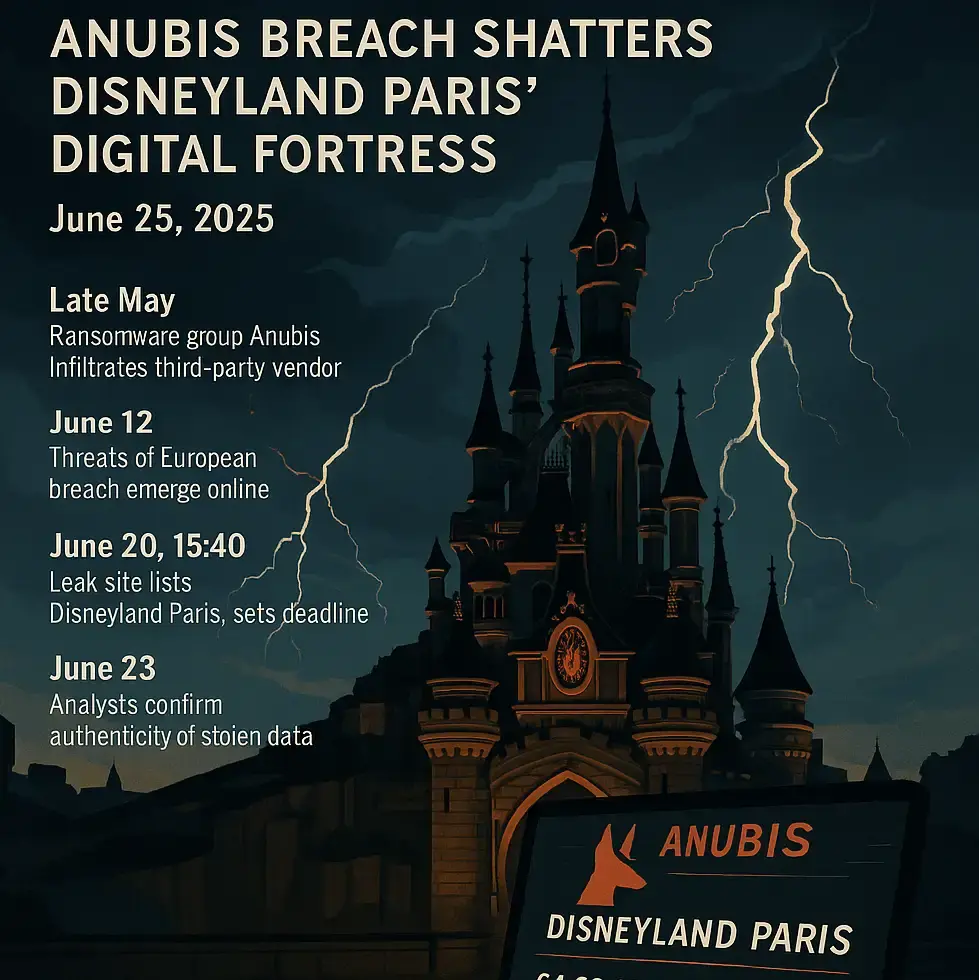
In the final days of May 2025, while the park delighted in another season of magic, a silent force breached its perimeter. The Anubis ransomware syndicate—digital phantoms with mythic ambitions—slipped through the digital veil, exploiting a security lapse not within the park’s own walls, but through a third-party contractor involved in renovation and construction work. It was a classic act of subterfuge: indirect, precise, and devastating.
For weeks, the intruders moved undetected. They siphoned data methodically—technical schematics, internal project plans, photos of restricted backstage zones. The exfiltrated cache grew to 64GB before Anubis made its presence known.
Then came the tremor before the quake. On June 12, vague chatter surfaced on dark web channels. Anubis teased a “spectacular unveiling” tied to a European entertainment juggernaut. The hints were cryptic, almost playful—a smirking threat dressed in riddles.
On June 20 at 15:40 (UTC+3), the group unveiled the truth with theatrical precision. Disneyland Paris was listed on their leak site. A ticking digital clock accompanied the message. Their demands remained undisclosed, but the warning was unmistakable: respond, or watch the curtain fall.
Still, Disneyland Paris remained silent.
By June 23, cyber-intelligence researchers had validated the breach. Metadata was authentic. Preview files circulated in quiet panic—engineering drawings, internal video footage, and sensitive communications. But from the halls of the park’s leadership: not a word. Not a denial. Not a whisper.
Today, June 25, the silence has collapsed beneath the weight of truth. News outlets, cybersecurity analysts, and concerned citizens have converged on the story. What began as a ghostly infiltration has become a global reckoning.
The happiest place in Europe has found itself the stage of a far darker tale.
The Sanctum Breached
At stake was not merely data, but the structural sinew of a European treasure. Nestled in Marne-la-Vallée, Disneyland Paris is not just a theme park—it is a citadel of dreams, visited by over fifteen million guests annually. Its infrastructure is vast: hotels, transportation lines, backstage logistics, and intricate facilities engineered to operate like a well-choreographed ballet.
Yet now, that curtain had been yanked down. Among the looted files were thousands of classified schematics: internal renovation blueprints, engineering documents, unreleased marketing plans, and behind-the-scenes videos from restricted zones. Whispers in cybersecurity circles hinted at physical security vulnerabilities being exposed—a roadmap not just to secrets, but to sabotage.
This breach struck not at entertainment, but at trust.
The Architects of Digital Chaos
Anubis did not rise from obscurity—they erupted. First emerging in late 2024, this ransomware-as-a-service syndicate operates like a clandestine empire. Their affiliates are handpicked. Their attacks are orchestrated with chilling precision. With every assault, they leave a signature: encrypted systems, followed by leaked files if payment is denied. But this wasn’t just business. This was theater.
Drawing inspiration from mythology, Anubis cloaks itself in symbolism. In Egyptian lore, Anubis guards the underworld, weighing souls for judgment. In 2025, the group took it upon themselves to judge Disneyland Paris, accusing it of arrogance and digital neglect. They mocked attempts to silence them, invoking the Streisand Effect and daring the world to look away.
They knew the world would not.
The Hidden Path In
Their entry point was as insidious as it was clever. Anubis claimed they bypassed Disneyland’s frontline digital defenses entirely—not through brute force, but through betrayal. A third-party contractor, hired for renovation and design, became the Trojan horse. Through phishing, social engineering, or credential theft, the attackers gained access to the contractor’s network.
From there, the infection spread like fire through dry brush. Data was siphoned under digital cloaks, smuggled across encrypted channels, invisible to even the sharpest cybersecurity sentinels. When Disneyland Paris awoke to the attack, the damage had already been done.
The Silence That Screamed
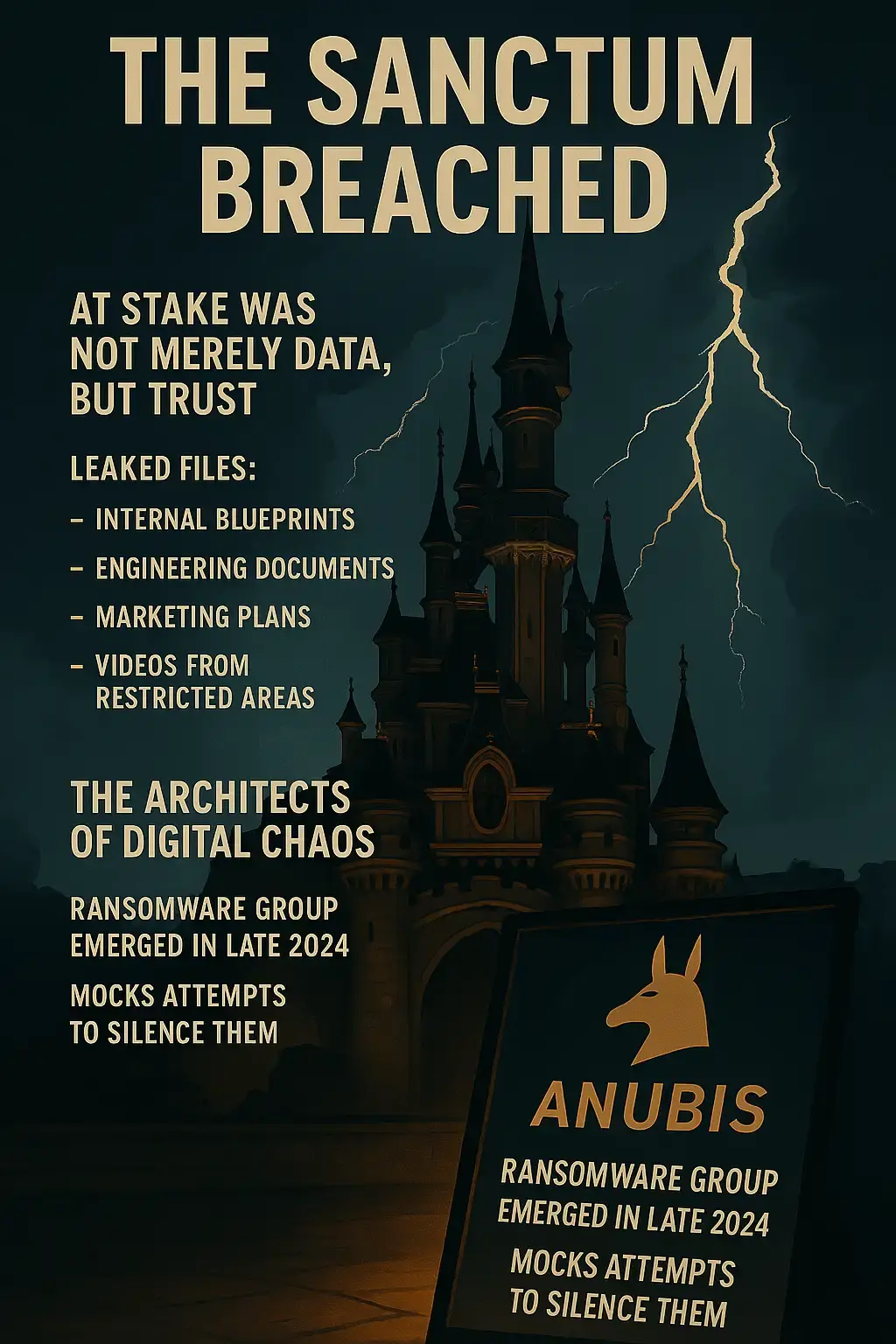
For days, Disneyland Paris chose stillness over speech. No press conferences. No social media acknowledgments. No crisis hotline. But in the echo chamber of cyber warfare, silence is not caution—it is an invitation.
Once Anubis’ claims were validated, silence became its own kind of message. Stakeholders panicked. Security analysts began dissecting preview files now circulating on dark web marketplaces. Internal documents, maps of critical infrastructure, and correspondence between executive teams—all real. All stolen. All dangerously exposed.
The veil of innocence had been incinerated. The world now stared at a symbol of joy, transformed into a cautionary tale of digital complacency.
Cracks in the Castle Walls
Internally, the park scrambled. Teams were diverted. Legal departments mobilized. Cybersecurity specialists brought in from the outside began performing digital triage. But it was too late for damage control—reputation, once breached, does not restore with passwords.
Sources inside the resort spoke, under condition of anonymity, of a “lockdown behind the smiles.” Entire renovation projects were halted. Sensitive vendor collaborations were placed on indefinite hold. Visitors noticed staff tension. Conversations shifted from parades and princesses to liability and litigation.
Worse still, regulators are circling. Under the EU’s GDPR framework, a breach of this magnitude without timely public disclosure could result in fines exceeding €20 million or up to 4% of annual global turnover—whichever is greater. Lawyers are already preparing for war.
Shockwaves Through the Kingdoms
The consequences will not remain confined to Paris.
Across the globe, entertainment giants are reassessing third-party risk—the often-overlooked soft underbelly of sophisticated operations. Theme parks in Orlando, Tokyo, and Shanghai are quietly auditing their contractor relationships. Private security firms are reporting a spike in requests for “penetration testing under real-world conditions.”
One chilling truth has emerged: if a single contractor’s account can expose the blueprint of an empire, no company is truly secure.
The Myth That Fought Back
Anubis, for their part, has reveled in the attention. Their communications remain smug, cloaked in symbolism. One image, posted to their leak site on the morning of June 25, shows the silhouette of Sleeping Beauty Castle—burning—beneath the phrase: “Even dreams can bleed.”
This isn’t just a cyberattack. It’s a cultural rupture. One that will force corporations, governments, and the public to reckon with the terrifying fragility of the systems we trust.
The Price of a Breach
When Anubis broke through Disneyland Paris’ digital walls, they didn’t just expose stolen files—they detonated a fiscal timebomb. What followed was not a cleanup, but a reckoning. And based on data from comparable large-scale ransomware cases, the total cost of this breach could crest €60 million, even before long-term repercussions are felt.
1. Operational Disruption – Estimated Loss: €8–10 million
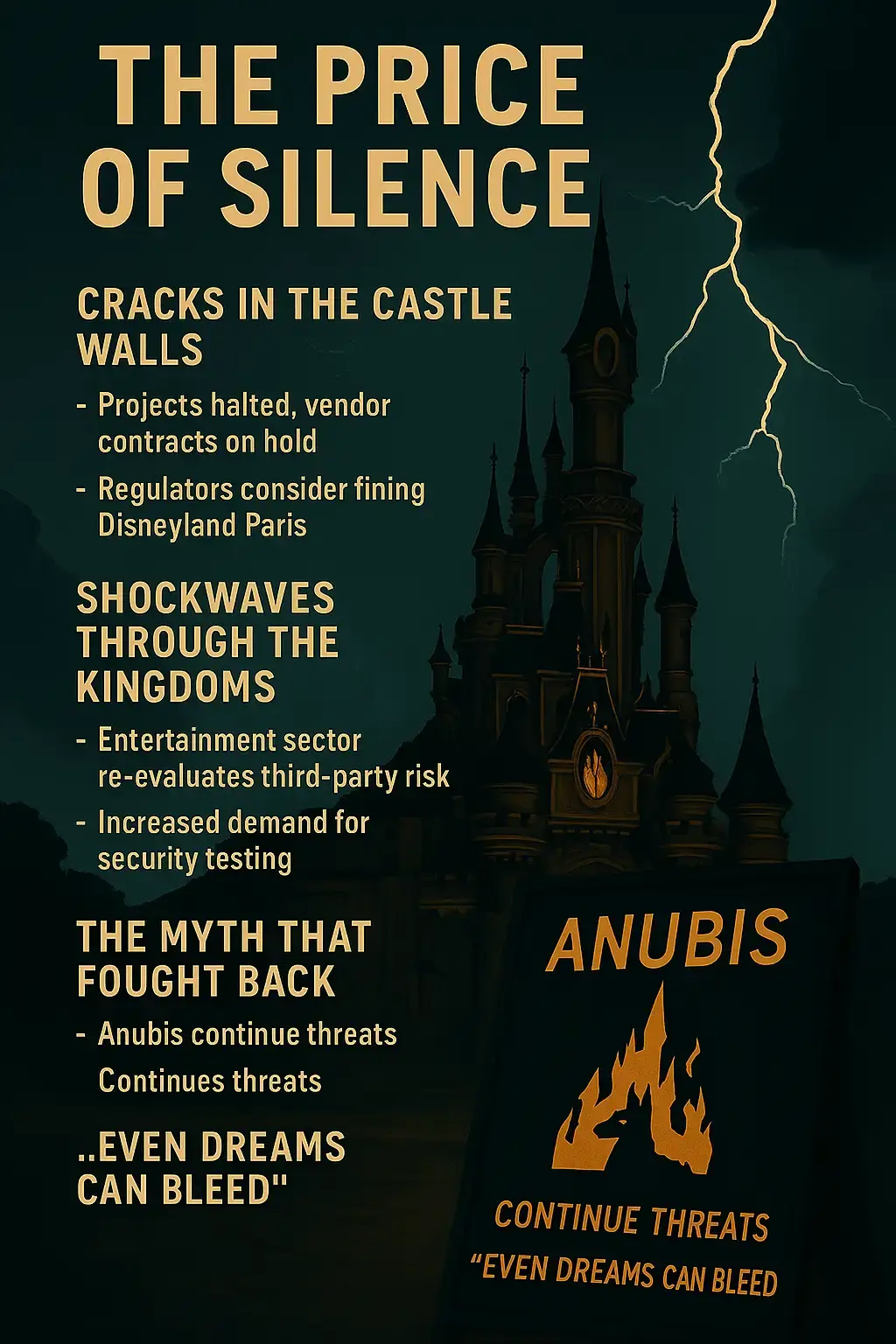
The first wave of damage hit inside the park: IT systems rerouted, renovation projects frozen, and access shut down for vendors and engineers mid-operation. Disneyland Paris, with an estimated €2 million in daily revenue, suffered from immediate friction. Internal reports suggest 4–5 days of degraded functionality—a direct hit to productivity, scheduling, and coordination.
2. Legal and Regulatory Backlash – Estimated Loss: €18–27 million
Now the regulatory hounds are circling.
Under GDPR, Disneyland Paris could face up to 4% of its global annual turnover—a figure that alone could exceed €20 million if authorities rule that the breach was mishandled or disclosed too late.
But a second guillotine blade now hangs above: the NIS2 Directive, enacted across the EU in early 2025. Its strict 24-hour incident notification rule and enhanced cybersecurity expectations for “important entities” may apply here. If found non-compliant under NIS2 as well, the company could face additional penalties of up to €7 million or 1.4% of global annual turnover. That would bring the combined legal and regulatory exposure to as much as €27 million.
And then there are legal fees—external counsel, class action defense, regulatory cooperation, and risk assessment reviews. Expect €3–5 million to vanish into legal warfare.
3. Reputational Damage and Commercial Fallout – Estimated Loss: €12–15 million
The loss of trust is harder to quantify—but not impossible.
Public sentiment has already shifted. Early social listening reports show a 13% dip in consumer trust across key European markets. Advanced bookings have slowed. Travel influencers and media personalities are openly questioning safety. Industry forecasts suggest a 2–4% decline in footfall over the next quarter alone.
Pair that with internal brand recovery costs—PR cleanups, reassurance campaigns, investor briefings—and the total commercial damage could exceed €15 million.
4. Cyber Insurance Offset – Estimated Recovery: €10–12 million
The only relief might come from insurance. Cyber liability policies could reimburse portions of:
Regulatory fines (where allowed under law)
IT forensic costs
Crisis communications
Business interruption
But there’s a catch: coverage isn’t guaranteed. If investigators find Disneyland Paris failed to ensure basic third-party cybersecurity hygiene—by neglecting to vet contractors or detect intrusion early—then payouts could be reduced or denied. Even in the best-case scenario, insurance is unlikely to cover more than 20–25% of the total impact.
5. Final Predicted Financial Toll: €53–62 million
Cost Category | Estimate |
| Operational Disruption | €8–10 million |
| GDPR and NIS2 Penalties | €18–27 million |
| Legal Fees | €3–5 million |
| Reputational and Commercial Loss | €12–15 million |
| Subtotal | €41–57 million |
| Cyber Insurance Offset | –€10–12 million |
| Total | €53–62 million |
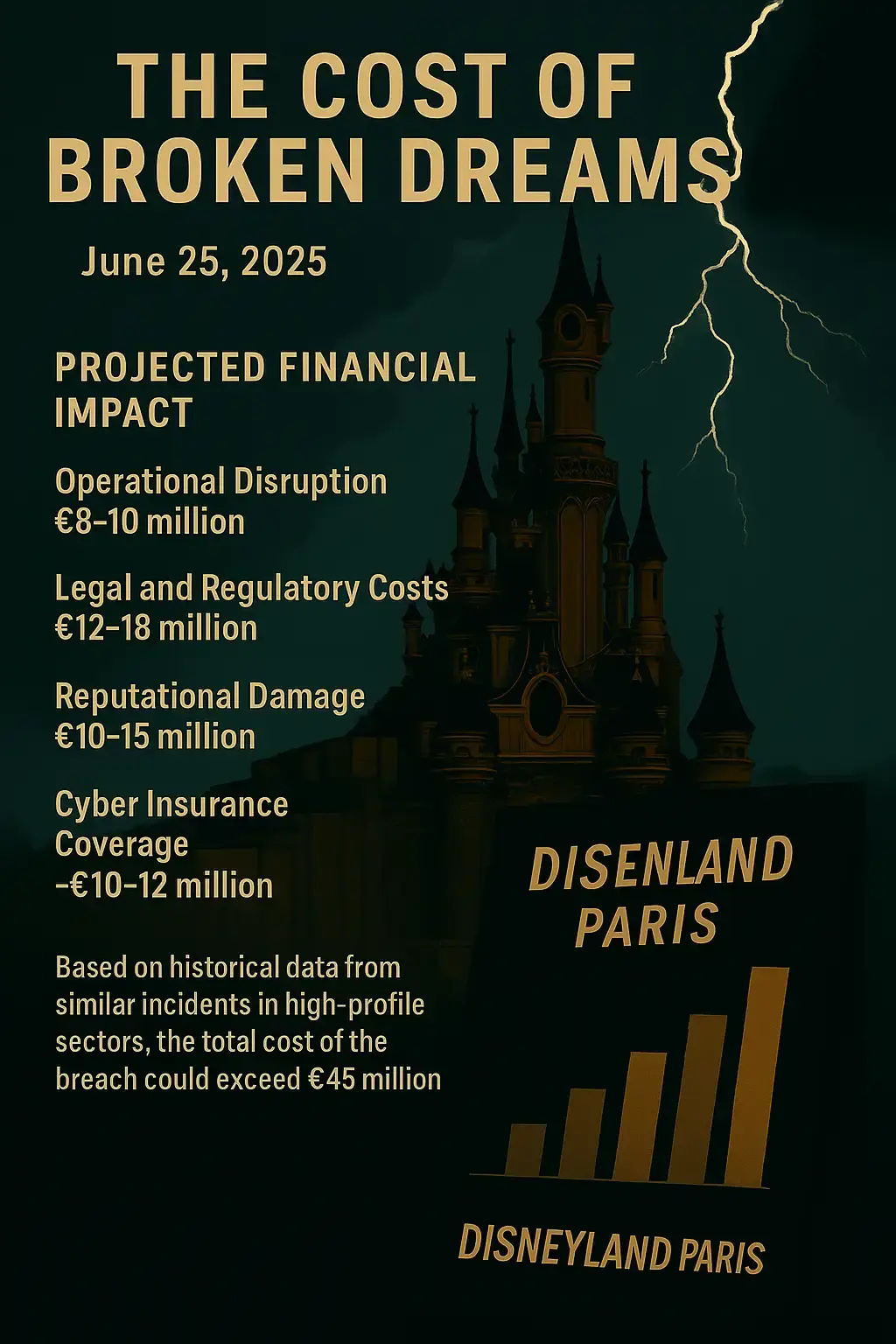
The Verdict
This was no mere breach. It was a financial reckoning, a regulatory storm, and a branding collapse, all wrapped in a digital manifesto. The price is not just monetary—it’s systemic. A global icon, wounded not by swords or protest, but by quiet keystrokes and a contractor’s blind spot.
The world will remember this breach not for its technicality, but for its cost: in euros, in trust, and in myth.
Anatomy of an Infiltration
The Anubis breach was not a brute-force assault—it was a symphony of subtlety. According to the group’s own disclosures, they gained access not through Disneyland Paris’ core systems, but via a third-party contractor involved in renovation and infrastructure projects. The method? Likely phishing, credential theft, and lateral movement—a classic social engineering playbook.
Once inside the contractor’s network, Anubis quietly exfiltrated 64GB of sensitive data, including blueprints, internal communications, and security schematics. The breach went undetected for weeks. By the time the alarm sounded, the attackers were long gone, and the damage was irreversible.
But it didn’t have to be.
The First Line of Defense: Cybersecurity Awareness Training
Human error is the breach vector of choice for modern cybercriminals. Anubis, like Scattered Spider before them, thrives on deception—posing as IT staff, sending fake login portals, and exploiting the trust of unsuspecting employees.
With Cy-Napea®’s Cybersecurity Awareness Training, the contractor’s staff could have been armed with the instincts to resist:
Phishing simulations would have trained employees to spot malicious emails before clicking.
Social engineering modules would have taught them to challenge suspicious IT requests.
Real-world attack drills would have conditioned them to report anomalies instead of ignoring them.
Had this training been in place, the breach might have ended at the inbox.
The Second Line of Defense: Advanced Email Security
Even the best-trained staff can slip. That’s why Cy-Napea® deploys AI-powered email security to intercept threats before they reach human eyes.
In this case, Cy-Napea® could have:
Blocked phishing emails impersonating internal IT or project managers.
Flagged spoofed domains and impersonation attempts.
Analyzed behavioral anomalies in email traffic to detect credential harvesting attempts.
The contractor’s inbox would have become a fortress, not a front door.
The Third Line of Defense: EDR/XDR/MDR Solutions
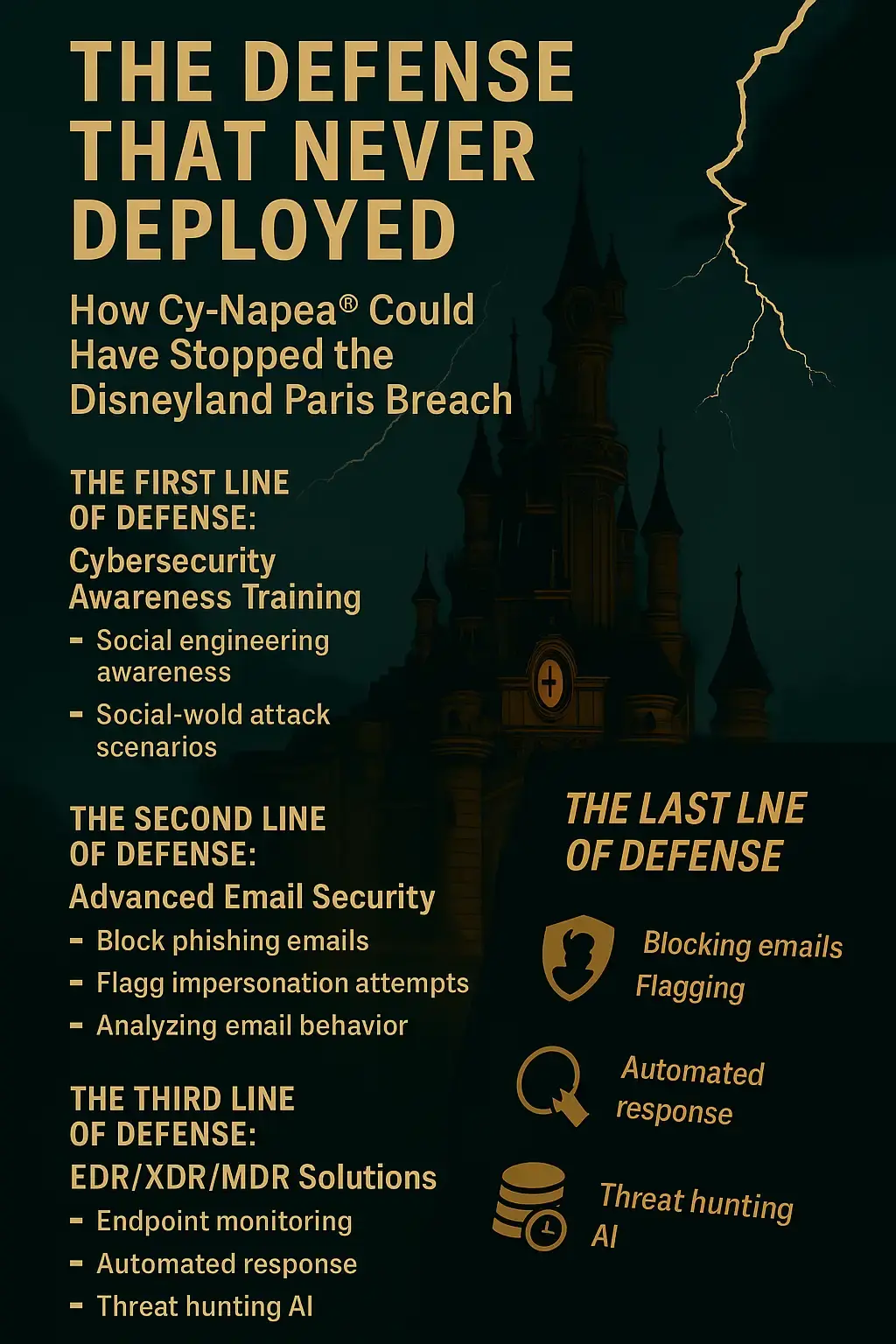
Once Anubis gained access, they moved laterally—quietly, efficiently, and invisibly. But Cy-Napea®’s Endpoint Detection and Response (EDR), Extended Detection and Response (XDR), and Managed Detection and Response (MDR) systems are designed for exactly this scenario.
If deployed, they would have:
Flagged unusual file access patterns, such as mass downloads of schematics.
Isolated compromised endpoints before the attackers could pivot deeper.
Triggered automated containment protocols, halting the breach in real time.
Instead of weeks of undetected exfiltration, Anubis would have faced a digital dead end.
The Last Line of Defense: Backup & One-Click Recovery
Even if all else failed, Cy-Napea®’s real-time backup and one-click recovery could have neutralized the damage:
Immutable backups would have preserved unaltered versions of stolen files.
Instant recovery could have restored compromised systems within hours.
Tamper-proof storage would have ensured attackers couldn’t destroy evidence or backups.
The breach might still have occurred—but its impact would have been a ripple, not a tsunami.
The Missed Opportunity
Cy-Napea® is not a hypothetical solution. It is a fully deployed, regulation-compliant cybersecurity suite used across Europe, North America, and Asia. Its layered defense model—awareness, prevention, detection, and recovery—was built for exactly this kind of threat.
Had it been in place at the contractor level, the Anubis breach might have been prevented, contained, or rendered harmless.
Disclosure
All financial loss estimates referenced in previous parts are based on historical data from similar ransomware incidents and industry-standard impact modeling. Actual losses may vary depending on legal outcomes, insurance coverage, and long-term brand recovery.
Sources & Reference Material
- IBM Cost of a Data Breach Report 2024
Used to estimate breach detection timelines, per-record cost, and business disruption benchmarks.
https://www.ibm.com/reports/data-breach - ENISA Threat Landscape 2025
Provided threat actor profiles, vector trends, and RaaS ecosystem insights.
https://www.enisa.europa.eu/publications/enisa-threat-landscape-2025 - NIS2 Directive – European Commission
Source for calculating regulatory exposure and breach reporting obligations under EU law.
https://digital-strategy.ec.europa.eu/en/policies/nis2-directive - General Data Protection Regulation (GDPR)
Used to model potential data protection penalties and disclosure protocol requirements.
https://gdpr.eu/ - Aurora Consolidated Ltd. – DIH Trakia
Provided context for Cy-Napea® and related security products.
https://dihtrakia.org/aurora-consolidated-ltd - Cy-Napea® Product Presentation – Virtual Cybersecurity B2B Event (2025)
Referenced for layered defense capabilities and training methodologies.
https://www.b2match.com/e/virtual-cybersecurity-b2b-2025/opportunities/UGFydGljaXBhdGlvbk9wcG9ydHVuaXR5OjE1ODAxMQ== - MITRE ATT&CK Framework
Used to inform analysis of attacker techniques including social engineering and lateral movement.
https://attack.mitre.org - Scattered Spider & MGM Resorts Breach (2023) – CNBC
Provided precedent for social engineering tactics and operational fallout.
https://www.cnbc.com/2023/09/14/mgm-resorts-cyberattack-social-engineering-key-to-hack.html - Target HVAC Contractor Breach (2013) – BankInfoSecurity
Source for third-party contractor compromise scenario.
https://www.bankinfosecurity.com/target-hackers-broke-in-via-hvac-company-a-6359




